|
Rugerís wonderful little Mini-14
has been with us for well over thirty years now, and it has
endeared itself to thousands of shooters, hunters, and law
enforcement officers during that time. It is a relatively simple
semi-automatic carbine based on an improved Garand gas
system.
The gas operating system on the Mini-14 series
of rifles uses a fixed piston that is extremely reliable and
durable. It works and works well. Lots of AR-15 shooters are
jubilantly peeing their pants over the latest craze of
piston-operated AR-15 rifles, as if it was a new idea using as
gas piston. The concept is very old, and even older than the
AR-15ís direct gas impingement system. Both systems work well
when properly executed. I have never heard of a Mini-14 gas
system breaking. The Mini is one of the most reliable semi-autos
ever built.
The only criticism of the Mini-14 that I ever
hear is the complaint of inaccuracy, which is largely unfounded.
The original Mini was never designed as a target rifle, as was
neither its inspiration, the M-1 Garand and M-14 rifles. Both of
these legendary rifles can be made into very accurate target
guns, but the original service grade weapons were built for
combat, not accuracy. It seems that shooters do not mind
at all spending a pocketful of cash to make a Garand into a
target rifle, but complain when a Mini-14 wonít deliver
one-hole performance right out of the box. That ainít right.
The Mini was never intended to be a target rifle. It is a
hunterís arm, and an excellent fighting weapon, and for both
of these purposes, the Mini-14 is every bit as accurate as it
needs to be, while maintaining its delightful handling
qualities. Same thing with the AR-15 rifles. In their
original form, they are plenty accurate for battle and hunting,
but making them into target grade weapons requires adding weight
and bulk to the handy little carbine.
Despite claims by some that the Mini-14 is not
accurate, that has not been my experience. Using quality ammo
produces good accuracy. Many shooters want to buy the cheapest
gun show third-world surplus ammo that they can find, and expect
target grade performance from their Mini-14, blaming the rifle
when it doesnít deliver. Our nation has for the most part
turned from a nation of hunters to a nation of paper shooters.
There is nothing wrong with shooting paper targets, as it tells
us much about a rifleís performance potential. However,
shooting from a machine rest atop a solid bench tells us little
about field performance. Still, shooters demand rifles
that shoot tiny groups, and Ruger has responded with the subject
of this review; the Mini-14 Target Rifle.
To the basic Mini-14 design, Ruger has added a
hammer forged heavy profile barrel and a stock that is
well-suited for bench work. The twenty-two inch barrel measures
.786 inch diameter forward of the gas block, and .669 inch under
the hand guard to the rear of the gas block. It has a
one-in-nine-inch rifling twist to accurately stabilize long,
heavy bullets, but still works well with short, light bullets
also. The heavy barrel profile adds stiffness and a greater
ability to absorb heat than does the standard barrel profile
used on the original Mini and the Ranch
Rifle. The most noticeable feature of the Target Rifle
is the harmonic barrel tuner. This device is attached near
the muzzle, and by loosening four Allen screws, a shooter can
fine tune the barrel vibrations for the best accuracy with a
particular load. The device has a wide latitude of adjustment,
and works along the same principle as the Browning BOSS
system introduced a few years ago, but the Ruger unit is much
more substantial and offers a much wider range of adjustment.
The rifle can be fired with the harmonic tuner in any position,
or with the unit completely removed from the weapon. In
practice, it works just like a handloader fine tuning his load
for the best accuracy, but the Ruger device offers the same
tuning advantage even when using factory ammunition, with the
minute adjustments made to the rifle instead of the ammunition.
The stock of the Target Rifle is a gray/black
laminated wood, with a radical thumbhole design that is very
comfortable to shoot from a bench or an improvised rested
position. The bottom of the fore end is wide and flat, adding to
the stability of the weapon from the bench or an improvised
field rest. The thumbhole stock is entirely ambidextrous, as is
the location of the safety, which is one of the better features
of the Mini-14 design and its predecessors, the Garand and M-14
service rifles. I shoot left-handed, and have never had a
problem with a Mini-14 shooting from the port side. It is a very
user-friendly design, and the new Target Rifle stock makes it
even more comfortable to shoot. The new stock and barrel
profile add weight to the Mini, and the sample rifle weighed in
at nine pounds and five ounces. This added weight also
lessens the felt recoil of the already mild .223 cartridge. That
will be a welcome feature to bench shooters and prairie dog
hunters, who sometimes shoot hundreds of rounds in a session.
The metal on the Target Mini is a matte
stainless steel, and is an excellent material for such a rifle.
It is low maintenance and good looking.
The overall length of the Target Rifle is
forty-two and one-half inches, but is adjustable by
adding/removing the buttplate spacers between the stock and
recoil pad. The Target Mini has no open or aperture sights, but
comes supplied with Rugerís integral scope bases and
detachable rings. The rifle is supplied with one
five-round magazine, but will use any Ruger or aftermarket
Mini-14 magazines as well. The trigger pull on the Target Mini
measured just over three and one-half pounds, which is lighter
than on any other Mini-14 that I have ever fired. It is a pretty
decent trigger feel. I like a bit lighter trigger for precision
target work, but the Mini trigger worked well for me, and
is a pretty good compromise between bench and field work.
It can also be improved a bit by some careful stoning of the
sear surfaces, but this should be left to a good gunsmith, if
you are not experienced in such matters.
While the new Mini-14 Target Rifle offers the
features for which shooters have been asking, the proof is in
the shooting. For general use, I mounted a Leupold
3.5 to 10 power VX-L scope. This design allows a very
large objective scope to be mounted over the Miniís relatively
high handguard. It is a great choice for hunting with the new
Target Rifle, but for serious bench rest paper punching, I
mounted my Leupold 6.5 to 20 power target scope. This scope
allows me to fully exploit the rifleís potential accuracy, at
least to the best of my ability. The Ruger performed well.
Shooters who have been hollering for better accuracy from the
Mini-14 can now shut up and shoot.
I tried the Target Rifle with a variety of
factory and handloaded ammunition, and every load tested
exhibited less than one minute-of-angle accuracy. Every
five-shot group fired went into one inch or less at 100 yards,
every time. I tried no steel-cased cheap junk ammo in the Mini,
but used quality factory ammunition from Black Hills and Winchester,
along with a few of my own handloads. Even the Winchester 62
grain full metal jacket (FMJ) white box ammo performed well, and
it is affordable enough for plinking.
The groups pictured were typical of those fired
on the day of accuracy testing. Accuracy and velocity testing
was done at temperature of around seventy-eight degrees
Fahrenheit, with a light wind and sunny conditions. The
velocities were checked on only four different loads, as the sun
was quickly setting and I ran out of reliable light for
chronograph work. Velocities were recorded using a PACT
chronograph, and the results are listed in the chart below. The
velocities are listed in feet-per-second (fps), and bullet
weights in grains.
| Ammunition |
Bullet Weight |
Velocity |
| Winchester FMJ |
62 grains |
3062 fps |
| Black Hills V-Max |
55 grains |
3191 fps |
| Handload Softpoint |
55 grains |
3126 fps |
| Winchester Silvertip |
55 grains |
3027 fps |
The accuracy of the Black Hills 55 grain V-Max
load was especially satisfying, placing five shots into just
five-eighths of an inch at 100 yards, and this was repeatable
all day long, until the ammo ran out. As stated above, I
was well pleased with the accuracy of every load tested.
For those who have been wanting a target grade
heavy-barreled Mini-14 without turning to the aftermarket; it is
here. For those who want competitive accuracy from a .223
semi-auto that is not an AR-15, this is your baby. The new Ruger
Mini-14 Target Rifle fills the bill, and it is available right
now, without a long wait on a custom gun.
Check out the full line of Ruger products
here.
For the location of a Ruger dealer near you,
click on the DEALER LOCATOR icon at: www.lipseys.com.
For a look at fine Leupold optics, go to: www.leupold.com.
Jeff Quinn
|
To locate a dealer where you can
buy this gun, Click on the DEALER FINDER icon at: |
|

|
  
Got something to say about this article? Want to agree (or
disagree) with it? Click the following link to go to the GUNBlast Feedback Page.
|
|
Click pictures for a larger version.
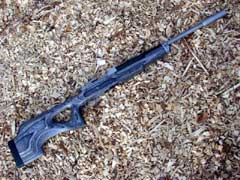
Ruger's new Mini-14 target Rifle.
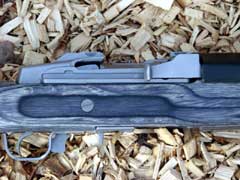
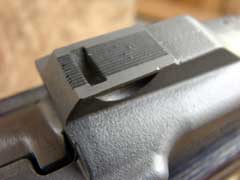
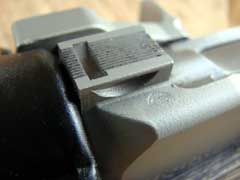
The Mini-14 Target features Ruger's integral scope
mounting system.
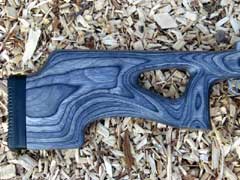
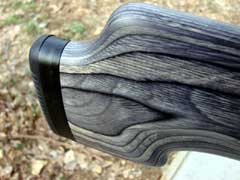
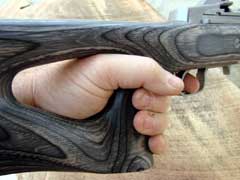
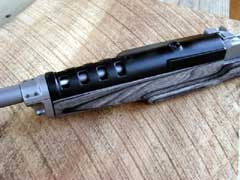
Gray/black laminated target-style stock adds weight and
excellent ergonomics.
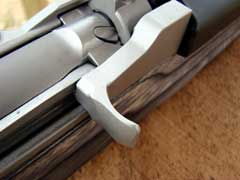
Operating handle is robust.
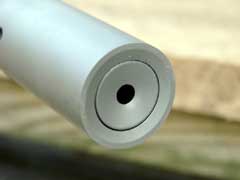
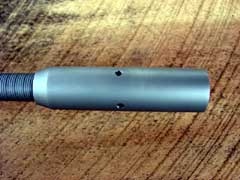
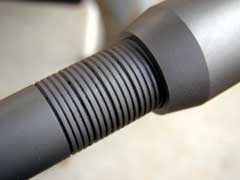
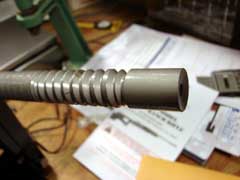
Harmonic barrel tuner allows the gun to be tailored to
the ammunition for optimum accuracy.
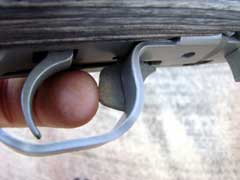
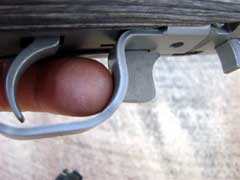
Safety is perfectly located for right-handed or
left-handed shooters.
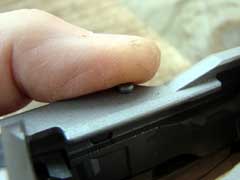
Bolt hold-open button.
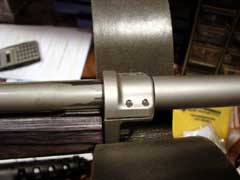
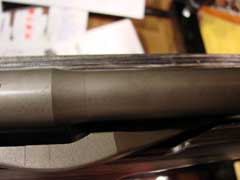
Among the accuracy enhancements found on the Mini-14
Target Rifle is a heavy barrel.
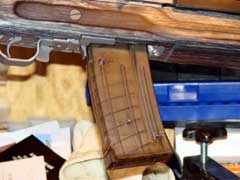
The Mini-14 Target Rifle will accept any factory or
aftermarket Mini-14 magazines.
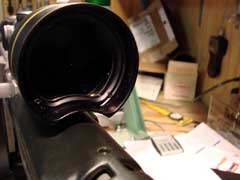
Leupold's VX-L scope easily clears handguard.
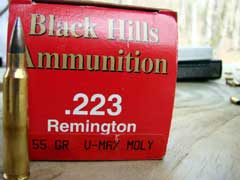
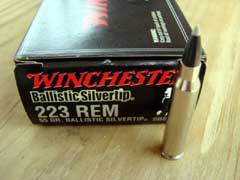
Some of the factory ammo used in testing.
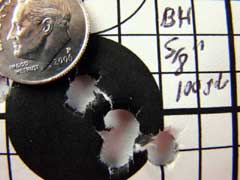
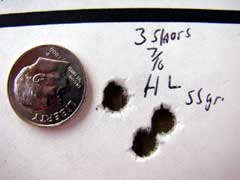
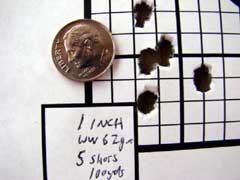
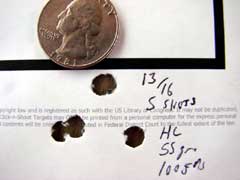
The Mini-14 Target Rifle can shoot!
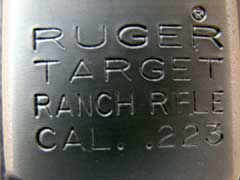
|
![]()